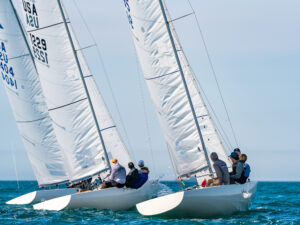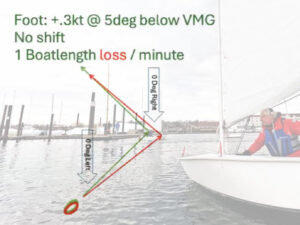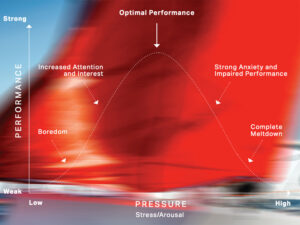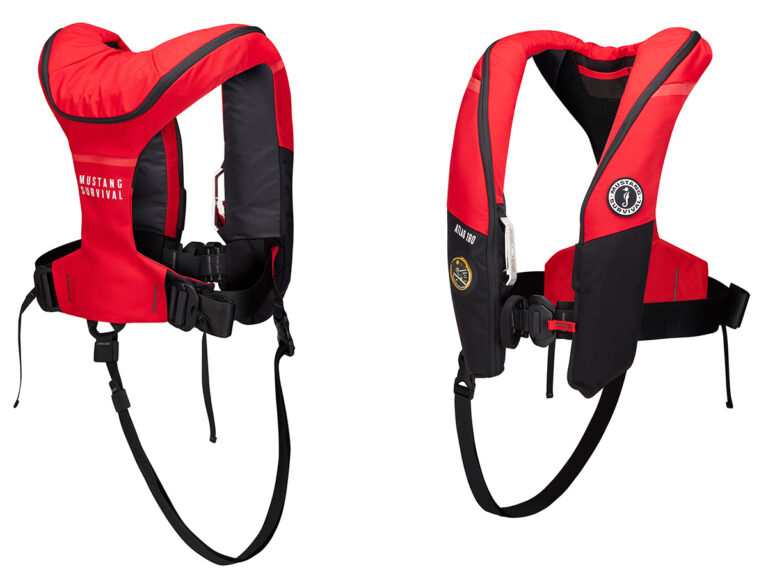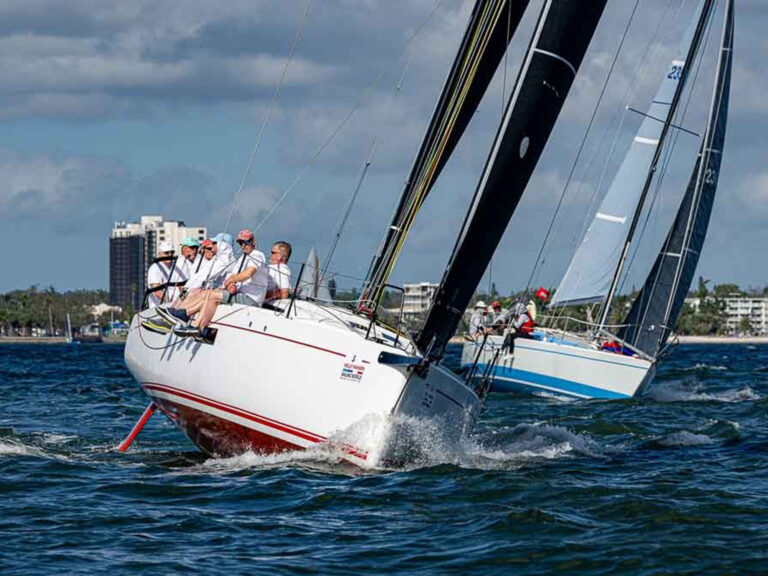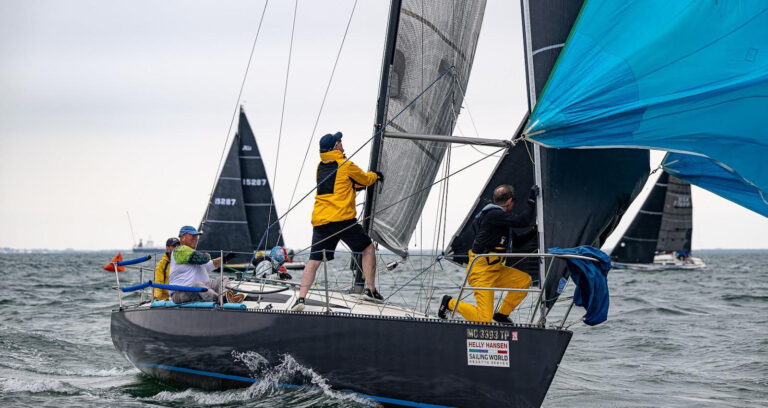
RoseJuly06
Imagine that you’re approaching the jibe mark and you have a small outside overlap on the boat just ahead of you. You see the inside boat having trouble with her spinnaker, leaving an enticing gap between herself and the mark. Should you take a chance and sail into that gap even though you know you’re not entitled to room? I will discuss four different gambles of this sort. For each one, I’ll spell out the rules and the risks involved, so that you can knowledgeably decide on a course of action.The first diagram (below) shows this little drama at the jibe mark. At position 1, Martha must keep clear (Rules 11 and 18.2(a)) and, while she and George are overlapped, give him room to round the mark (Rule 18.2(a)). Before he jibes George must not sail farther from the mark than his proper course would take him (Rule 18.4).After Martha becomes clear astern of George between positions 1 and 2, and if she is overlapped inside George at position 2, Rule 18.2(b) applies. It requires Martha to continue keeping clear of George and to continue giving him room, and it states that she “is not entitled to room.” Note that Rule 18.2(b) does not prohibit Martha from taking room if George gives it to her. Rule 18 continues to apply until the mark is astern of both boats, and during that time Rule 16.1 does not apply to George when he changes course to round the mark (Rules 18.1 and 18.4(d)). Of course, Rule 14 applies to both boats at all times.So, under what circumstances would Martha break a rule if (after position 2) she sailed into the gap between George and the mark? If George luffed very close to Martha before she left the mark astern, and thereby demonstrated that he had to curtail his luff to avoid contact with her, Martha would break Rule 18.2(a). However, if George is unable to tame his spinnaker in time to luff close to Martha, then she breaks no rule by sailing between him and the mark.The second diagram (top right) shows a common leeward mark situation. It differs from the first situation in that Rule 18.2(c) applies and Rules 18.2(b) and 18.4 do not. Mary and Abe are about to round from a run onto a beat. After Mary reaches the two-length zone clear ahead of Abe, Rule 18.2(c) requires him to keep clear of her while she rounds the mark and, if later he becomes overlapped between her and the mark, it states that he is not entitled to room.Just as in the incident involving George and Martha, Rule 16.1 does not apply to Mary as she luffs to round the mark. However, if Mary were to turn past head to wind Rule 18.2(c) would no longer apply, and Mary would be required by Rule 13 to keep clear of Abe (see Rule 18.2(c)’s last sentence).Here is the risk that Abe faces if he sails into an inside overlap between Mary and the mark. He breaks Rule 18.2(c) if, before he leaves the mark astern, Mary has to curtail her luff in order to keep clear of him. However, if Mary cannot luff that high that soon, or if she does so after Abe passes the mark and Abe keeps clear, then Abe does not break Rule 18.2(c). And, if Mary turns past head to wind and as a result Abe has to take action to avoid her before she reaches a closehauled course, then Mary breaks Rule 13.The third diagram depicts a situation in which Jack, on starboard tack, and Jackie, on port, converge near a windward mark, which is to be left to starboard. Jackie tacks to leeward and clear ahead of Jack. At position 1 when the first of the pair enters the zone Rule 18 does not apply because the boats are on opposite tacks on a beat to windward.When two boats are on opposite tacks and Rule 18 does not apply, they are never said to ‘overlap’ or to be ‘clear ahead’ or ‘clear astern’ of one another (see the last sentence of the definition Clear Astern and Clear Ahead; Overlap). For these reasons the conditions under which Rule 18.2(b) or 18.2(c) would apply are not met and, therefore, neither of those rules apply. In addition, Rule 18.3 does not apply here because Jack was not fetching the mark when Jackie completed her tack inside the two-length zone.Unlike Martha and Abe, Jack can sail into the gap between the other boat and the mark with little risk of breaking a rule. Jackie has right of way over Jack under Rule 12, but he can easily keep clear. Moreover, if she tacks before he has rounded the mark, she will very likely break a rule. Here’s why: If Jackie luffs up to head to wind, the boats will become overlapped and Rule 18.2(a) will require her to give Jack room, and if she turns past head to wind, Rule 13 and then Rule 10 will require her to keep clear of Jack. Jack must remember that, after he obtains right of way (when Jackie turns past head to wind), he must not change course in a way that deprives Jackie of room to keep clear (Rule 16.1).The fourth diagram shows yet another situation in which a boat would love to sail into a gap-but this time the gap is between a right-of-way boat and a continuing obstruction-a river bank. Hillary and Bill are both on starboard tack running in light wind. They are trying to stay as close as possible to the shore to escape the effect of a strong contrary current.The rules that apply in this case are quite different from those in the three other cases we have considered. While boats are passing a continuing obstruction, Rule 18.5 applies and Rules 18.2(b) and (c) do not.While Bill is clear astern of Hillary, Rule 12 requires him to keep clear. The rule that applies if Bill sails into the gap between Hillary and the shore depends on whether or not at the moment an overlap between the boats begins there is room for Bill to sail between Hillary and the shore. If there is, Bill may blanket Hillary and obtain an inside overlap. He will then have right of way under Rule 11 and the right to room under Rule 18.5’s second sentence. However, if there is not enough room, then according to Rule 18.5’s last sentence, Bill is not entitled to room and must keep clear of Hillary even though he becomes the leeward boat.This is definitely a case in which Bill is gambling if he goes between Hillary and the shore. If he manages to sail for a couple of lengths in a seamanlike manner without touching the bank, the bottom, or Hillary, then he wins the gamble by demonstrating that there was indeed the room required by Rule 18.5. In that case he is within his rights to remain between Hillary and the shore, and Hillary is obligated by Rule 18.5 to give him room and by Rule 11 to keep clear of him. Otherwise he breaks Rule 18.5. (This situation was discussed in detail in the March ’06 issue.)In the next issue I’ll discuss more situations in which boats sometimes gamble while passing a mark or obstruction.E-mail for Dick Rose may be sent to rules@sailingworld.com.

